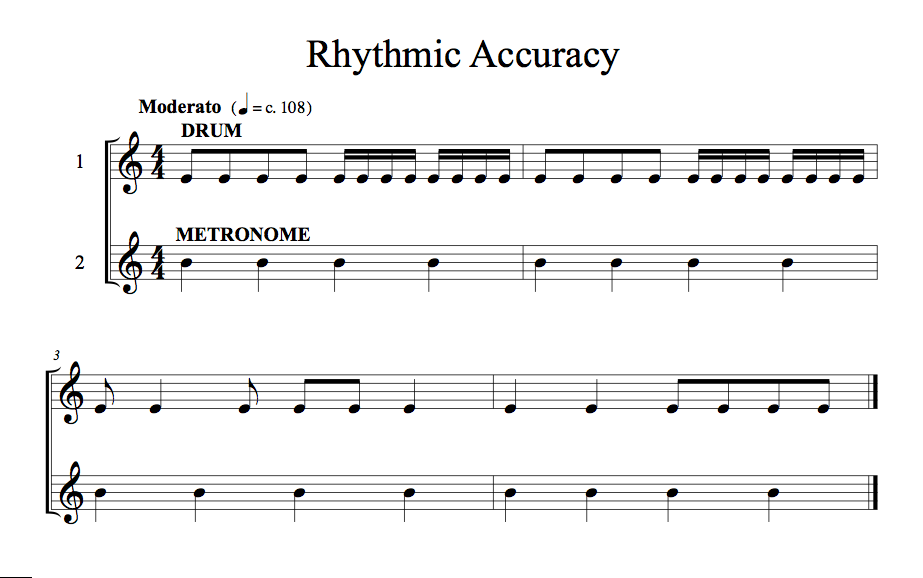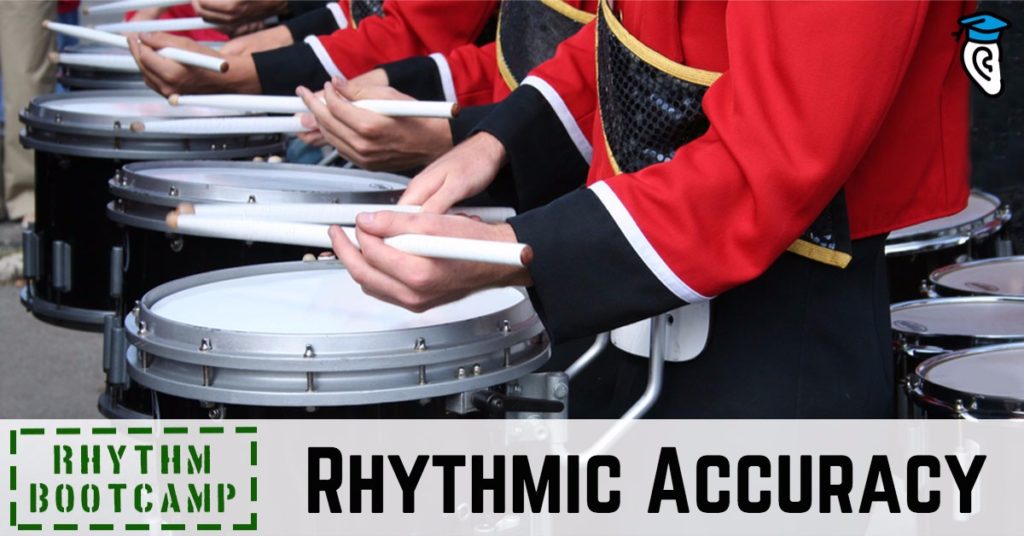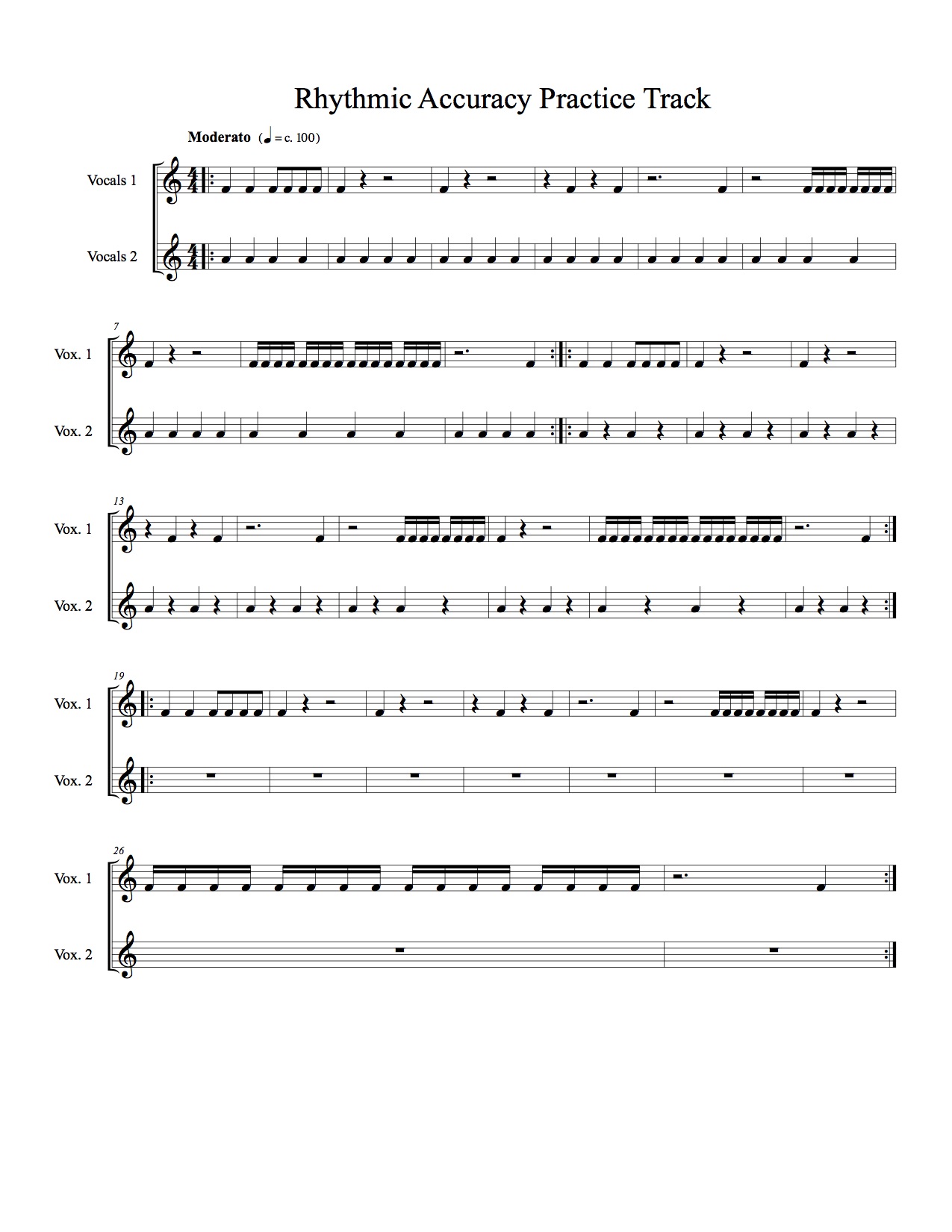In Rhythm Boot Camp: Got No Rhythm? you worked on basic techniques like audiation and counting to develop your musical skills. In this article you will practice your rhythmic accuracy.
Many musicians may have general good rhythm, able to play most rhythmic figures that they encounter. However many musicians, even seasoned musicians, struggle with rhythmic accuracy.
Comedian Will Ferrell has trouble keeping time as he battles Pro Drummer Chad Smith in a Drum-Off
Without rhythmic accuracy you may have a tendency to rush or drag during the performance, lose your place during a solo, or flub common figures in practice. Developing rhythmic accuracy is very important in practice, otherwise you risk teaching yourself how to play pieces incorrectly and training your body to play the wrong notes.
What is Rhythmic Accuracy?
Rhythmic accuracy means playing a rhythmic pattern exactly on time. This means that your notes are not ahead of the beat, behind the beat, or simply playing the wrong figure entirely.
Here is an example of good rhythmic accuracy. Listen to the snare drum play in time to the beat.

Did you hear how the snare drum is right on the beat? It does not rush or drag the figure. Now in the next example, can you hear a difference in the performance?
In this example, the snare drum is no longer playing in time. It stretches and contracts the rhythmic figures, causing the drummer to play inaccurately. Maybe you have encountered this situation before, where a musician in your band (or maybe even you?), could not keep the beat.
What Causes Rhythmic Inaccuracy?
Losing rhythmic accuracy happens for many reasons, but generally there are three key reasons a musician may get out of time:
- Playing ahead of the beat
- Playing behind the beat
- Misinterpreting a rhythm
Playing Ahead of the Beat
Most of us have been there in live performance: running through a difficult passage at high speed only to find that we are way ahead of the beat. In other words, we have played our music too quickly and end up reaching the next measure before the band gets there.
As a percussionist, I know that drummers often struggle with rushing, especially in fast sections full of excitement and energy. Adrenaline pumping, it sometimes gets too hard to remember to slow down instead of hoping that the band will catch up as you wow your fans with drumming awesomeness!
Here is an example of a drummer having good rhythmic accuracy:
Now listen to the same drummer rushing the tempo:
Can you hear how the drummer reached the beat ahead of time? Listen again, this time tapping the tempo as the drummer plays. Can you anticipate where the drummer is missing the beat? Can you catch where the mistakes are being made? Is the drummer ever in tempo and do they attempt to correct their error? Use your listening skills to evaluate and pick apart how this drummer has played ahead of the beat.
5 Ways to Avoid Rushing the Beat
- Don’t forget to breathe while you play a difficult passage. If you find the adrenaline is pumping and you are making mistakes, you might just need to calm yourself down and take deep breaths.
- Memorize any hard sections. If the section is committed to memory, you can concentrate on rhythmic accuracy instead of worrying about notes.
- Listen to the band. Many times I will key in to the pianist or the guitarist, trying to find a balance in tempos when in a live situation. In some cases, like a large orchestral or choral setting, you might find that there are several tempos jumping around. At that point, try to keep to the conductor, rhythm section, or drummer, ignoring other sections that may be dragging or rushing the tempo.
- Pay attention to the tempo in very fast passages. In fast passages with many running notes, you may find that you have jumped ahead of the ensemble by missing a note or speeding up in a slurry of 16th note mayhem.
- Count and subdivide in slow passages and during multi-measure rests. Slow passages have a tendency to bore us, especially if we are not playing or at least holding out chords or long notes. Because of this, especially in situations without a conductor, the best bet is to subdivide by counting in your head. For example, you may count “1&2&3&4&” instead of “1-2-3-4” during a slower passage. Tapping your foot can help. During long multi-measure rests, take note of any cues that will help you if you lose track of time or anticipate your entrance. For example, maybe the trumpet section gives a loud accented blast right before you come in with your riff. Use this as a cue for your entrance.
Dragging the Rhythm
Playing behind the beat is just as much of a problem as rushing. In some styles of music, like jazz or blues, you might be directed to slightly drag the beat to give it a more easygoing feel, but in most styles of music, you want to avoid dragging a rhythm.
Like rushing the tempo, playing behind the beat or just getting lost in a song because you lose track of time, can be a problem that is easily solved by knowing your music well, counting in your head, and being mindful of the ensemble.
Misinterpreting Rhythms
Another key problem that many musicians face involves misinterpreting a rhythm. Examples of this can be misreading a rest, counting extra beats in a rhythmic figure, or even confusing syncopated rhythms with triplet rhythms.
A good way to avoid these problems is to learn how to count rhythms accurately and be prepared before performing. This way, when you are confronting a difficult rhythmic figure, your musical training will help you play it accurately.
The Talking Rhythm ear training series includes basic exercises to help you count rhythm.
Take the time to explore these three articles to further develop your rhythmic accuracy. Listen to the examples and practice these exercises daily to help you develop good rhythmic accuracy.
Exercise: Rushing or Dragging?
In this simple exercise you are going to practice keeping good time. At the beginning of the example, you will hear the metronome play steadily. Eventually the metronome will drop out and the drum will continue to play. As you play, see if you anticipate the beat or drag it behind? Are you in time? Continue practicing this exercise until you are able to internalize the beat and play with rhythmic accuracy.
Instructions
- Listen to the example once through.
- Tap the rhythm with the example.
- Listen for where you might rush or drag behind, especially when the metronome drops out.
- Continue practicing this exercise until you have rhythmic accuracy.
Conclusion
Continue practicing good rhythmic accuracy every day. Use a metronome when practicing, and listen to your performance. Are you rushing? Are you dragging a rhythm? Where do you lose time?
Isolate sections that are giving you difficulty. If possible, memorize them and play them concentrating on rhythmic accuracy and execution.
While it might be fun to play a song from beginning to end over and over again, or just jamming with friends, you will only get better by isolating problem areas in a tune and perfecting them until you can play without error. Most rhythmic accuracy issues can be avoided by preparation, good everyday practice with a metronome, and counting. But even with with a good general accuracy, you might find some trouble spots – click here to learn what to do.









